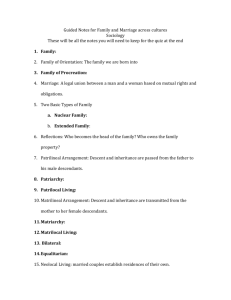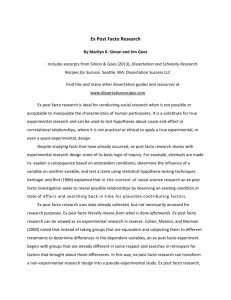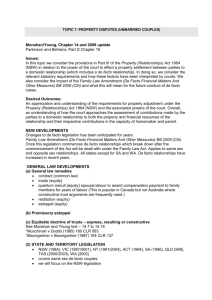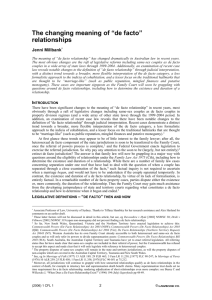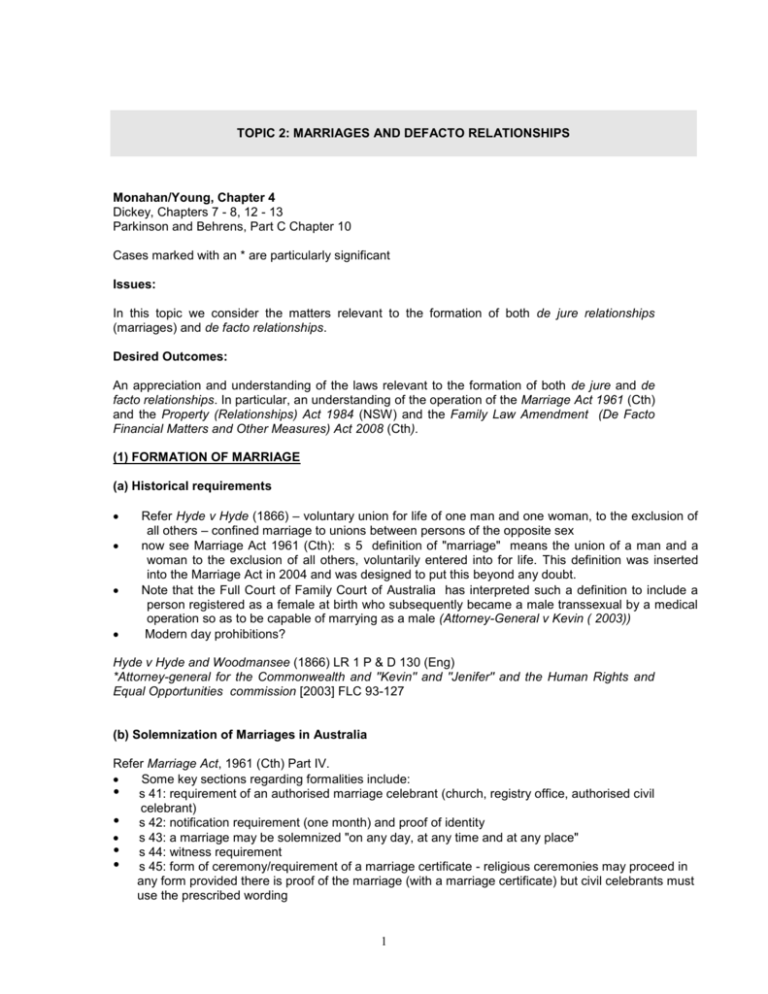
TOPIC 2: MARRIAGES AND DEFACTO RELATIONSHIPS
Monahan/Young, Chapter 4
Dickey, Chapters 7 - 8, 12 - 13
Parkinson and Behrens, Part C Chapter 10
Cases marked with an * are particularly significant
Issues:
In this topic we consider the matters relevant to the formation of both de jure relationships
(marriages) and de facto relationships.
Desired Outcomes:
An appreciation and understanding of the laws relevant to the formation of both de jure and de
facto relationships. In particular, an understanding of the operation of the Marriage Act 1961 (Cth)
and the Property (Relationships) Act 1984 (NSW) and the Family Law Amendment (De Facto
Financial Matters and Other Measures) Act 2008 (Cth).
(1) FORMATION OF MARRIAGE
(a) Historical requirements
Refer Hyde v Hyde (1866) – voluntary union for life of one man and one woman, to the exclusion of
all others – confined marriage to unions between persons of the opposite sex
now see Marriage Act 1961 (Cth): s 5 definition of "marriage" means the union of a man and a
woman to the exclusion of all others, voluntarily entered into for life. This definition was inserted
into the Marriage Act in 2004 and was designed to put this beyond any doubt.
Note that the Full Court of Family Court of Australia has interpreted such a definition to include a
person registered as a female at birth who subsequently became a male transsexual by a medical
operation so as to be capable of marrying as a male (Attorney-General v Kevin ( 2003))
Modern day prohibitions?
Hyde v Hyde and Woodmansee (1866) LR 1 P & D 130 (Eng)
*Attorney-general for the Commonwealth and "Kevin" and "Jenifer" and the Human Rights and
Equal Opportunities commission [2003] FLC 93-127
(b) Solemnization of Marriages in Australia
Refer Marriage Act, 1961 (Cth) Part IV.
Some key sections regarding formalities include:
• s 41: requirement of an authorised marriage celebrant (church, registry office, authorised civil
celebrant)
• s 42: notification requirement (one month) and proof of identity
s 43: a marriage may be solemnized "on any day, at any time and at any place"
• s 44: witness requirement
• s 45: form of ceremony/requirement of a marriage certificate - religious ceremonies may proceed in
any form provided there is proof of the marriage (with a marriage certificate) but civil celebrants must
use the prescribed wording
1
•
s 46: civil celebrants must explain nature of the marriage relationship (the wording is set out in the
section).
W v T [1998] FLC 92-808
Also note some key sections in Part II regarding marriageable age:
• s 11: marriageable age: the age is ....
• s 12: judicial power to authorise a marriage where one party is under age
• s 13: parental consent
also note ss 14-21
(c) Solemnization of Australian Marriages Overseas
Refer Marriage Act, 1961 (Cth) Part V
Historically our embassies could assist but now limited to ‘defence force’ marriages
(d) Recognition of Foreign Marriages
Common law: lex loci celebrationis: see Berthiame v Dastous (1930) AC 70. If there are no local rules
then there must at least be a ceremony involving an exchange of mutual vows before an especially
ordained priest: see R v Millis (1844) 8 ER 844; Kuklycz v Kuklycz (1972) VR 50.
Now refer Marriage Act 1961 (Cth) Part V.
(e) Validity of marriage: s 113 of FLA
The provisions of s 113 are as follows:
“Proceedings for declarations
113. In proceedings of the kind referred to in paragraph (b) of the definition of matrimonial cause
in subsection 4(1), the court may make such declaration as is justified.”
Ex Parte Willis [1997] FLC 92-725
*Lester and Lester [2007] FamCA 186, (2007) FLC 93-308, (2007) 37 Fam LR 488
(2) DE FACTO RELATIONSHIPS
Property (Relationships) Act 1984 (NSW)
NSWLRC Report 36 (1983) ‘De Facto Relationships’
commenced 1 July 1985
significantly amended on 28 June 1999 by the Property (Relationships) Legislation Amendment
Act 1999 to include same sex couples
Act now distinguishes de facto relationships from domestic relationships
it is primarily a property and spousal maintenance act
Part I: Preliminary
Part II: Jurisdiction
Part III: Proceedings for financial adjustment
Part IV: Agreements
Part V: Domestic violence and harassment
Part VI: Miscellaneous
2
The former De Facto Relationships Act 1984 was amended by the Property (Relationships) Legislation
Amendment Act 1999 which commenced on 28 June 1999.
Section 4(1): defines ‘de facto relationship’: a relationship between two adult persons who live together
as a couple and who are not married to each other or related by family. Also note the definition of a
‘domestic relationship’ in s 5 (that includes a de facto relationship). See D v McA (1986) for the 10
relevant matters are (per Powell J) but now incorporated into s 4(2)
1.
2.
3.
duration of the relationship - now see s 4(2)(a)
nature and extent of common residence - now see s 4(2)(b)
sexual relationship - now see s 4(2)(c)
- whether or not a sexual relationship existed or not
4. degree of financial dependence - now see s 4(2)(d)
- and any arrangements for support, between or by the parties
5. ownership, use and acquisition of property - now see s 4(2)(e)
6. procreation of children – no direct equivalent in PRA
7. care and support of children - now see s 4(2)(g)
8. performance of household duties - now see s 4(2)(h)
9. degree of mutual commitment and support - now see s 4(2)(f)
10. reputation and public aspects of the relationship - now see s 4(2)(i)
Interstate comparison?
•
•
NSW, Vic, NT (and SA)
ACT, Qld, Tas and WA
Referral of Powers to the Commonwealth
•
•
Commonwealth Powers (De Facto Relationships Act) 2003 (NSW) commenced on 22 September
2008
Vic, S.A, Tas and Qld have also ‘referred’
Family Law Amendment (De Facto Financial Matters and Other Measures) Act 2008 (Cth)
received Royal Assent and partially entered into force on 21 November 2008 – inserts by s 4AA
(not yet in force – expected to commence on March 2009) the following definition of “de facto
relationships” into the FLA.
“ Meaning of de facto relationship
(1) A person is in a de facto relationship with another person if:
(a) the persons are not legally married to each other; and
(b) the persons are not related by family (see subsection (6)); and
(c) having regard to all the circumstances of their relationship, they have a
relationship as a couple living together on a genuine domestic basis.
Paragraph (c) has effect subject to subsection (5).
Working out if persons have a relationship as a couple
(2) Those circumstances may include any or all of the following:
(a) the duration of the relationship;
(b) the nature and extent of their common residence;
(c) whether a sexual relationship exists;
(d) the degree of financial dependence or interdependence, and any arrangements
for financial support, between them;
(e) the ownership, use and acquisition of their property;
3
(f) the degree of mutual commitment to a shared life;
(g) whether the relationship is or was registered under a prescribed law of a State
or Territory a prescribed kind of relationship;
(h) the care and support of children
(i) the reputation and public aspects of the relationship.
(3) No particular finding in relation to any circumstance is to be regarded as necessary in
deciding whether the persons have a de facto relationship.
(4) A court determining whether a de facto relationship exists is entitled to have regard to
such matters, and to attach such weight to any matter, as may seem appropriate to the
court in the circumstances of the case.
(5) For the purposes of this Act:
(a) a de facto relationship can exist between 2 persons of different sexes and between 2
persons of the same sex; and
(b) a de facto relationship can exist even if one of the persons is legally married to
someone else or in another de facto relationship.
When 2 persons are related by family
(6) For the purposes of subsection (1), 2 persons are related by family if:
(a) one is the child (including an adopted child) of the other; or
(b) one is another descendant of the other (even if the relationship between them is
traced through an adoptive parent); or
(c) they have a parent in common (who may be an adoptive parent of either or both
of them).
For this purpose, disregard whether an adoption is declared void or has ceased to
have effect.
D v McA (1986) 11 Fam LR 214
Sim v Powell (1997) 22 Fam LR 243; DFC 95-191
PY and CY [2005] DFC 95-323
*Delany v Burgess [2007] NSWCA 360
4






